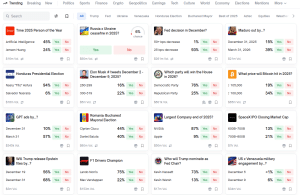CryptoCurrency
Polymarket Builds Internal Market-Making Team

Join Our Telegram channel to stay up to date on breaking news coverage
Polymarket is recruiting staff for an internal market-making team that could trade against its users, Bloomberg reported.
The report, which cited sources familiar with the matter, said Polymarket has approached traders, including sports bettors, about joining its own market making team. Market makers quote buy and sell prices to keep trading smooth, but an internal desk means the platform itself could take the other side of customer positions.
“Polymarket has been recruiting new staff members for an internal market making team that could face off against customers on the company’s exchange, even though a similar feature has exposed its chief rival to criticism.”
Polymarket Builds In-House Trading Team as It Re-Enters… pic.twitter.com/hVuYT11TKi
— Alfonso Straffon 🇨🇷🇺🇸🇲🇽 (@astraffon) December 4, 2025
The development comes as Polymarket re-enters the US market after being forced out in 2022 following enforcement action from the Commodity Futures Trading Commission (CFTC). It was ordered to cease operating in the US and pay a $1.4 million civil penalty.
Prediction Market Competition Heats Up
Competition in prediction markets is intensifying. Main rival Kalshi already operates its own trading desk, a model that has drawn user criticism and even a proposed class-action lawsuit last month that alleges unfair advantages.
Both Kalshi and Polymarket have already approached third parties to fulfill a market-making role on their respective platforms. Companies like Susquehanna International Group have subsequently started offering market-making services on Kalshi. Galaxy Digital is also reportedly in talks to offer its services.
Prediction markets let users buy and sell contracts that are tied to real-world events. Prices in a contract reflect the market’s implied odds of that outcome happening. If the event occurs, the contract pays out.


Market available on Polymarket (Source: Polymarket)
Prediction markets gained traction during the US presidential election when they accurately predicted Donald Trump’s victory, even while many traditional polls forecast a win for Kamala Harris.
Since then, Polymarket and Kalshi have risen to become the dominant players in the space. In November, both platforms experience their best month on record, data from Token Terminal shows.
Last month, Kalshi’s spot volume climbed to $5.8 billion, a 32% increase compared to October’s $4.4 billion. This also marked the company’s biggest monthly gain on record.
Similarly, Polymarket also posted its biggest month after the New York-based platform saw its monthly volume rise from $3.02 billion in October to $3.7 billion in November. The gain extended record-setting activity for the platform.
MetaMask Moves Into Prediction Markets With Polymarket Integration
As Polymarket plans to build an internal market-making team, Web3 wallet MetaMask has integrated with the popular prediction market platform.
“You can now trade on the future outcome of real world events inside your wallet,” Consensys’ Gabriela Helfet wrote in a recent blog post. “You’ll also earn MetaMask Rewards points with every prediction you make.”
Not only will MetaMask users be able to access Polymarket via their wallets, they will also be able to fund their accounts using “any token on any EVM chain” with “one tap funding.”
That is the latest integration by a major platform or company with a prediction market. Both Kalshi and Polymarket have announced multi-year partnerships or strategic partnerships with companies such as the UFC, NHL, Google, and others.
Related Articles:
Best Wallet – Diversify Your Crypto Portfolio
- Easy to Use, Feature-Driven Crypto Wallet
- Get Early Access to Upcoming Token ICOs
- Multi-Chain, Multi-Wallet, Non-Custodial
- Now On App Store, Google Play
- Stake To Earn Native Token $BEST
- 250,000+ Monthly Active Users
Join Our Telegram channel to stay up to date on breaking news coverage










